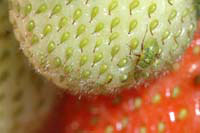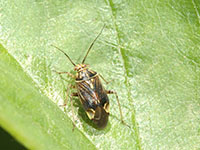Extension > Garden > Diagnose a problem > What's wrong with my plant? > Fruit > Strawberry > Deformed fruit
Strawberries > Fruit > Deformed fruit
1 of 2
Tarnished Plant Bug
Lygus lineolaris
- Feeding results in a berry with a deformed, seedy tip (cat-faced berry)
- Adults are oval shaped, approximately 1/4 inch long, brownish in color with streaked yellow and black lines (tarnished appearance), and have a white V-shaped marking on its back
- Nymphs may be confused with aphids, however, they move fast when disturbed (aphids do not)
- Adults are present early in the season (April-May), and again in high numbers in late June-July; nymphs present in May
- More prevalent in weedy strawberry patches
- Remove weeds as they can provide habitat for adults to feed and overwinter
- Keep lawn mowed so that it does not become a habitat area
- If your patch is small enough, you can physically remove insects by tapping the flowers and dislodging them into a pan of soapy water
- More information on tarnished plant bug
2 of 2
Frost Injury
- Berry is puckered or misshapen on any side of the berry, usually with a suture mark between the normal and deformed sides of the berry
- The first and largest berry is often deformed, later berries are not affected
- Deformed and healthy fruit appear in the same cluster
- Center of the flower is black








